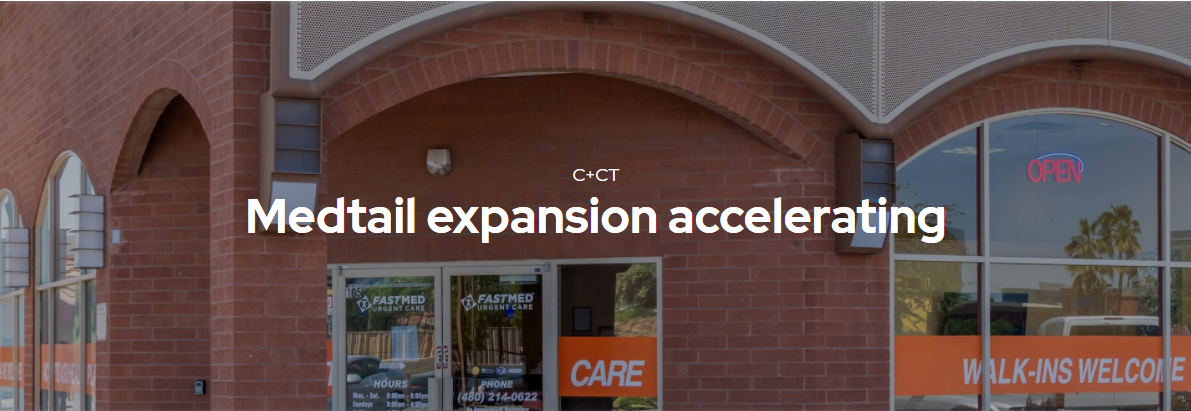
Medtail Expansion Accelerating
Medical users have been expanding in shopping centers for roughly a decade as health care providers moved to offer patients more convenience. In 2019, nearly 28,000 shopping centers in the U.S. included a healthcare tenant, up from about 21,600 in 2013, according to CoStar.
And this medtail migration has only intensified during COVID-19. In a recent survey conducted by commercial real estate advisory firm Tether Advisors, 79% of private equity, commercial real estate and retail healthcare executives expected investments in medtail companies to increase over the next year. That’s due in part to the enhanced focus consumers are placing on health, wellness and accessibility in light of the pandemic.
Some healthcare organizations have hired real estate staff, thereby enhancing their ability to understand and negotiate retail leases. Additionally, it’s clear that medtail users are just as interested in presenting branded experiences to their customers today as they have been in providing convenience in the recent past.
“Over the last 12 months, we have signed eight medical tenants in our centers,” said Brett Horowitz, a partner and asset manager with Branch Properties, which develops and owns grocery-anchored centers throughout the Southeast. “These tenants are aggressive and are making sure that they have highly-visible, front-row placement. And they’re paying top-dollar rents for the locations.”
Doctor groups, dental groups and urgent care clinics make up the primary medical users in the Branch Properties portfolio, and such tenants typically want outparcel or endcap locations, Horowitz added. Recent deals include a 4,500-square-foot lease with One Medical in a suburban Atlanta center Branch is developing. In the Tampa, Florida, metro, a local doctor’s group will occupy a 4,000-square-foot former bank that Branch initially envisioned converting to a restaurant.
But beyond those users, the medtail category encompasses yoga studios, gyms and specialized medical services like kidney dialysis and mental health counseling centers, observers said. Similarly, Walgreens’ incorporation of as many as 700 VillageMD primary clinics in its stores and Oak Street Health’s deal to operate primary and urgent care clinics in Texas Walmarts illustrates the breadth of health care potential in the retail space.
Medtail tenants are increasingly attracted to the economic benefits of retail space, said Jason Wollum, retail practice leader for Henderson Engineers. Healthcare tenants can spend upwards of $500 per square foot to build an acute care facility. Codes and regulations that he maintains may not apply to the services being offered can drive the cost up, he said, but shopping centers provide a flexible and cost-effective way to experiment with different services while driving brand loyalty.
“Healthcare systems are expanding their reach out into the communities at a time when there’s an abundance of retail space available,” Wollum said. “If you visit a specialized clinic in a retail center just down the street, you’re more likely to visit that hospital brand when you need the type of care that a big healthcare system provides.”
Class B properties may provide lease terms that are a better fit for medtailers than Class A properties, Wollum said, and there’s an opportunity for brokers and developers to educate medtailers that don’t know about retail lease nuances like common area maintenance charges, co-tenancy clauses and tenant-finish allowances.
In either case, landlords are beginning to differentiate between healthcare systems that deliver a consistent experience through design, branding and service and thus can drive traffic and those that plop down an urgent care clinic in the cheapest space available, Wollum said. For example, One Medical, a membership-based primary care practice that’s expanding after going public in early 2020, incorporates some of the most upscale and high-end finishes, part of its focus on patient comfort, Horowitz said.
From a design standpoint, developers must integrate medtailers in a way that fosters cross-shopping, said Sandy Sigal, president and CEO of NewMark Merrill Cos., whose medtail tenants include Pacific Dental Services, L.A. Care Health Plan and dialysis clinics. “If you want your shopping center to be at the center of the community, you’ve got to provide the right mix of tenants,” he said. “And medical and healthcare, from gyms all the way to specialized care, are users that you want to make sure you nail down” in the tenant mix.
As recently as five years ago, more traditional tenants still might have pushed back against medtail tenants or even exercised rights to keep them out. Now, they realize medtail tenants bring more consumers, Sigal noted. “It has been a 180-degree change. Our tenants see that medical users are a plus, not a minus.”
From www.icsc.com. Click here to read the full article.
